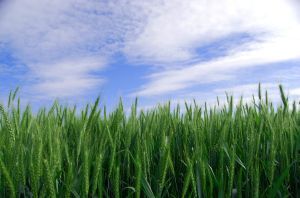Congress has cut federal funding for public media — a $3.4 million loss for LAist. We count on readers like you to protect our nonprofit newsroom. Become a monthly member and sustain local journalism.
This archival content was written, edited, and published prior to LAist's acquisition by its current owner, Southern California Public Radio ("SCPR"). Content, such as language choice and subject matter, in archival articles therefore may not align with SCPR's current editorial standards. To learn more about those standards and why we make this distinction, please click here.
A Crisis Coming for American Farmers?

Famine. Riots. Strikes. Inflation. The repercussions of the world food crisis continue to affect the global mood and economy, and unfortunately the situation does not appear to be getting any better. American farmers, most of whom rely on the core crops of wheat, corn, and soy to bring in a living, are fearful of another poor harvest this year. From the NY Times:
United States soybean plantings are running 16 percent behind last year. Rice is tardy in Arkansas, which produces nearly half the country’s crop. “We’re certainly not going to have as good a crop as we had hoped,” said Harvey Howington of the Arkansas Rice Growers Association. “I don’t think this is good news for anybody.” Harvests ebb and flow, of course. But with supplies of most of the key commodities at their lowest levels in decades, there is little room for error this year. American farmers are among the world’s top producers, supplying 60 percent of the corn that moves across international borders in a typical year, as well as a third of the soybeans, a quarter of the wheat and a tenth of the rice.
As Editor-in-Chief of our newsroom, I’m extremely proud of the work our top-notch journalists are doing here at LAist. We’re doing more hard-hitting watchdog journalism than ever before — powerful reporting on the economy, elections, climate and the homelessness crisis that is making a difference in your lives. At the same time, it’s never been more difficult to maintain a paywall-free, independent news source that informs, inspires, and engages everyone.
Simply put, we cannot do this essential work without your help. Federal funding for public media has been clawed back by Congress and that means LAist has lost $3.4 million in federal funding over the next two years. So we’re asking for your help. LAist has been there for you and we’re asking you to be here for us.
We rely on donations from readers like you to stay independent, which keeps our nonprofit newsroom strong and accountable to you.
No matter where you stand on the political spectrum, press freedom is at the core of keeping our nation free and fair. And as the landscape of free press changes, LAist will remain a voice you know and trust, but the amount of reader support we receive will help determine how strong of a newsroom we are going forward to cover the important news from our community.
Please take action today to support your trusted source for local news with a donation that makes sense for your budget.
Thank you for your generous support and believing in independent news.

-
With less to prove than LA, the city is becoming a center of impressive culinary creativity.
-
Nearly 470 sections of guardrailing were stolen in the last fiscal year in L.A. and Ventura counties.
-
Monarch butterflies are on a path to extinction, but there is a way to support them — and maybe see them in your own yard — by planting milkweed.
-
With California voters facing a decision on redistricting this November, Surf City is poised to join the brewing battle over Congressional voting districts.
-
The drug dealer, the last of five defendants to plead guilty to federal charges linked to the 'Friends' actor’s death, will face a maximum sentence of 65 years in prison.
-
The weather’s been a little different lately, with humidity, isolated rain and wind gusts throughout much of Southern California. What’s causing the late-summer bout of gray?







